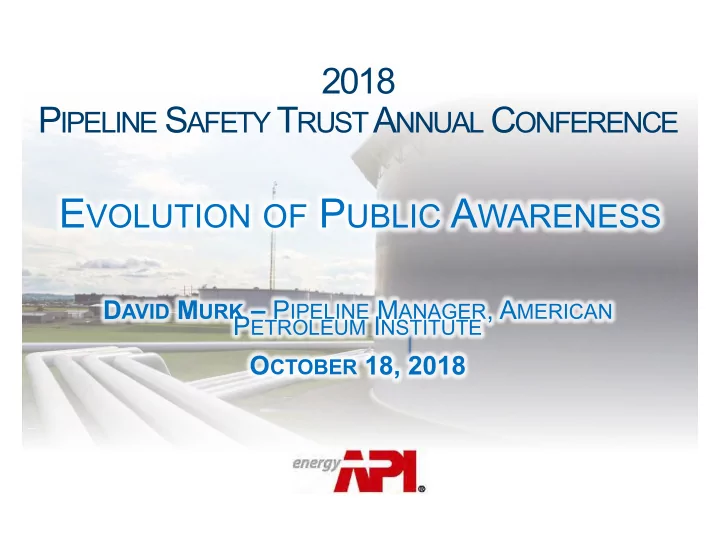

2018 P IPELINE S AFETY T RUST A NNUAL C ONFERENCE E VOLUTION OF P UBLIC A WARENESS D AVID M URK – P IPELINE M ANAGER , A MERICAN P ETROLEUM I NSTITUTE O CTOBER 18, 2018
E VOLUTION OF P UBLIC A WARENESS A great deal of effort has gone into RP 1162 awareness efforts and inspections—many lessons learned. Dec May Dec Dec 2020 2005 2010 2003 API RP API RP 1162 Projected PHMSA adopts 1162 1 st 2 nd edition API RP 1162 by reference. edition finalized 3 rd edition Final rule finalized published 2
C HANGES TO RP 1162 • 1 st Edition: Requires pipeline operators to provide pipeline safety information to affected public, emergency officials, public officials and excavators. • 2 nd Edition: Revisions include messages, delivery frequency and methods, geographic coverage areas, program evaluation and other elements. • 3 rd Edition: Starting with RP 1162, 2 nd edition. Reviewing findings and recommendations from PHMSA-led PAPWG and API 1162 Team. Align with RP 1173. Also looking at RP 1162, 1 st edition. 3
3 RD E DITION : W HERE W E S TAND N OW • Scope: o Refers to active pipelines o Excludes abnormal operations o Provides room to consider operational changes that may impact public safety • Consultants engaged to provide guidance on o Effectiveness measurement, o Risk communication, o Message mapping and o Public engagement on infrastructure projects • Three work groups formed and developing recommendations 4
3 RD E DITION : W ORKING G ROUPS • Audience Definitions and Messaging o Focusing on the relevancy and appropriate audiences o Reviewing messaging through a Risk Communication lens (where appropriate) to confirm effective messaging for each audience group • Effectiveness Measurement o Through stakeholder input, assessing current measurement practices o Reviewing and evaluating leading measurement practices used in similar public awareness campaigns/requirements in other industries • Engagement and Influence o Review of leading practices for engagement to reach diverse audience groups 5
3 RD E DITION T IMELINE • August 2017: First call • 2017-2018: o Quarterly task group meetings, in-person; work group meetings or calls as needed o Work groups meeting as needed to meet objectives, beginning to develop draft sections • 2019: Focused on writing the document • Dec. 2019: Complete draft document • 2020: API Public Awareness Voting Group, public comment period o All comments must be addressed • Mid-2020: Final document, ready for publication by API 6
10 Y EARS OF P UBLIC A WARENESS E FFECTIVENESS Affected Public knowledge at an all-time high (92%) 7
A LL S TAKEHOLDERS F EEL M ORE I NFORMED Affected Public knowledge at an all-time high (92%) 8
E VOLVING F ROM A WARENESS TO E NGAGEMENT Two-way Communication with External Stakeholders • Regulators, Public Stakeholder Groups, Neighbors • Beyond awareness and pure communication • Communicating about safety operations and risk management • Acknowledging notification may be next evolution • Other opportunities exist for engagement outside the public awareness outlined in RP 1162 9
External SMS Engagement Guidance Strong commitment to engage with external stakeholders Engagement policy and plan in place for two-way communication • • Communicated throughout organization by leaders and field champions Operators share safety performance with those that live, work and plan in proximity to their pipelines A mechanism is in place for stakeholders and the operator to have an ongoing dialogue with those that wish to do so, regarding safety and asset-related concerns Personnel are made available to the public to receive and exchange information 10
W HAT MORE SHOULD WE BE DOING ? • Should there be some means of acknowledgment? • Is the notification approach right to the audience? • What does risk communications mean to you? • Should we measure behavior change vs. the intent to change behavior? 11
T HANK Y OU David Murk Pipeline Manager American Petroleum Institute 202-682-8080 murkd@api.org Energyinfrastructure.org Pipelinesms.org 12
Recommend
More recommend